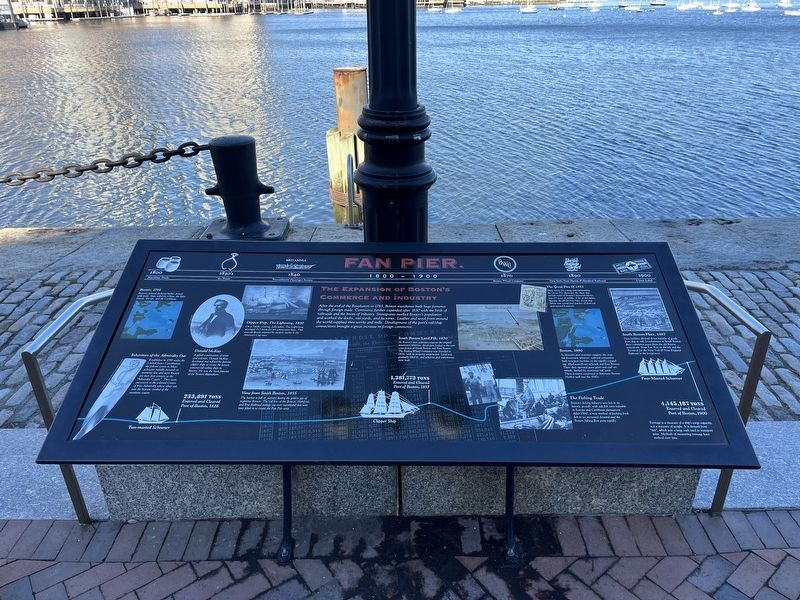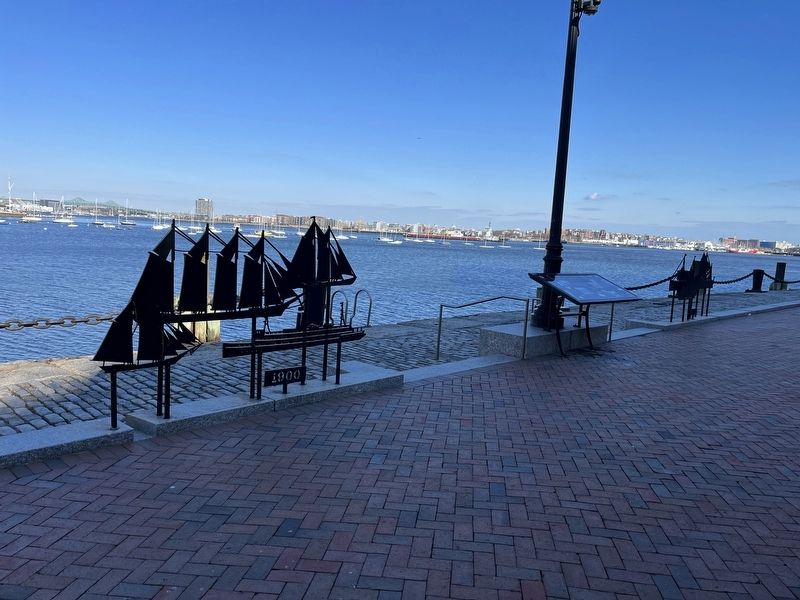South Boston Waterfront in Suffolk County, Massachusetts — The American Northeast (New England)
Fan Pier.
1800 - 1900
The Expansion of Boston's Commerce and Industry
After the end of the Revolution in 1783, Boston merchants built huge fortunes through foreign trade. Commerce further expanded after 1830 with the birth of railroads and the boom of industry. Immigrants swelled Boston's population and worked the docks, rail yards, and factories. Leather and wool around the world supplied shoe works and mills. Development of the port's rail/ship connections brought a great increase in foreign commerce.
[Captions:]
Boston, 1795
Boston's natural sheltered harbor thrived with trade. Ships sailed for China, the Spice Islands, Europe, and the Caribbean.
Inheritors of the Admiralty Oar
Established in 1789 under the United States Constitution, the federal courts in Massachusetts initially focused on maritime law and were known for their first century as the "Admiralty Courts." They were successors to the colonial Courts of Vice Admiralty whose silver oar was the historic symbol of the maritime courts.
Donald McKay
A gifted combination of artists and scientist, Donald McKay developed and refined his famous clipper ships to create the fastest commercial sailing ships in history. He was the most famous of the Boston shipmakers.
Clipper Ship, The Lightning, 1850
On a Pacific crossing, fully laden. The Lightning averaged 15.5 knots for ten consecutive days. This exceeds speeds attained by modern yachts on the America's Cup race.
View from South Boston, 1855
The harbor is full of activity during the golden age of maritime Boston. The rail line of the Boston, Hartford, and Erie Railroad swings out over marshland that was later filled in to create the Fan Pier area.
South Boston Land Fill, 1870
As Boston's port activities outgrew the original downtown wharves, developers looked to the vast waterfronts of South Boston and East Boston. The Boston Wharf Company was founded in 1836, with its property underwater. Land was gradually filled in, and wharves and warehouses were built.
The Great Fire of 1872
Sheet music for a song commemorating the Great Fire illustrates the blaze that turned much of Boston's financial district into 56 acres of rubble. A lot of this debris became the fill for Fan Pier; if you dug below you would find patches of charcoal and twisted ironwork.
Boston, 1880
As Boston's port activities outgrew the original downtown wharves, railroad companies
The Fishing Trade
Boston's fishing industry was key to its historic growth, with salt fish very valuable in Europe and Caribbean plantations. AFter 1860, a new method of packing fresh fish in ice increased demand and the Boston fishing fleet grew rapidly.
South Boston Flats, 1887
New facilities allowed direct transfer of goods from ship to rail. Development in South Boston drew commerce away from the old waterfront. Note Fan Pier on the left and the Terminal for the New York & New England Railroad in the foreground.
233,891 tons entered and cleared Port of Boston, 1826
1,381,773 tons entered and cleared Port of Boston, 1857
4,145,187 tons entered and cleared Port of Boston, 1900.
Tonnage is a measure of a ship's cargo capacity, not a measure of weight. It is derived from "tun", which was a large cask used to transport wine. Methods of measuring tonnage have evolved over time.
[Timeline:]
1800: Maritime Trade
1830's: Ice Trade
1840: Transatlantic Passenger Service
1870: Boston Wharf Company
1890: New York, New Haven & Hartford Railroad
1900: Union Label
Topics. This historical marker is listed in these topic lists: Industry & Commerce • Railroads & Streetcars • Waterways & Vessels. A significant historical year for this entry is 1783.
Location. 42° 21.299′ N, 71° 2.811′ W. Marker is in Boston, Massachusetts, in Suffolk County. It is in South Boston Waterfront. Marker is on Harborwalk north of Northern Avenue, on the left when traveling north. Touch for map. Marker is at or near this postal address: 1 Courthouse Way, Boston MA 02210, United States of America. Touch for directions.
Other nearby markers. At least 8 other markers are within walking distance of this marker. A different marker also named Fan Pier. (within shouting distance of this marker); a different marker also named Fan Pier. (within shouting distance of this marker); The Way to a Cleaner Harbor (within shouting distance of this marker); Boston Harbor Islands (about 400 feet away, measured in a direct line); Captain John Foster Williams (approx. 0.2 miles away); Four Point Channel (approx. ¼ mile away); InterContinental Boston Hotel (approx. ¼ mile away); The Boston Tea Party (approx. ¼ mile away). Touch for a list and map of all markers in Boston.
Credits. This page was last revised on February 4, 2023. It was originally submitted on February 4, 2023, by Devry Becker Jones of Washington, District of Columbia. This page has been viewed 317 times since then and 54 times this year. Photos: 1, 2. submitted on February 4, 2023, by Devry Becker Jones of Washington, District of Columbia.

